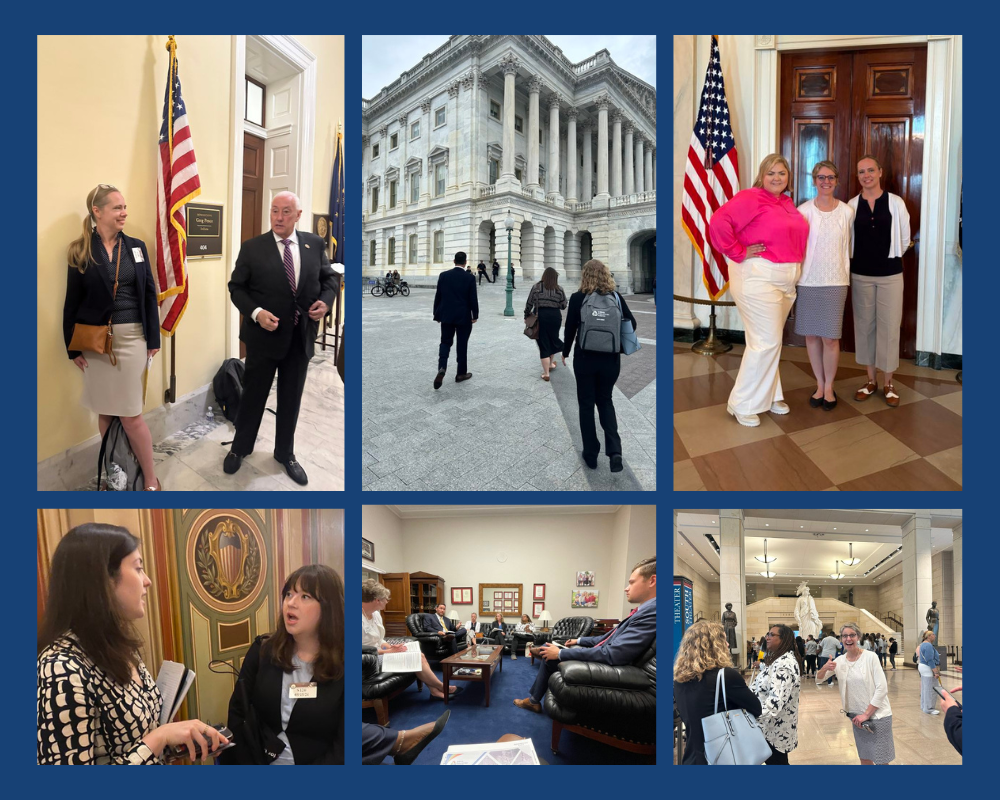Reflections from Washington

Last week, Indiana Philanthropy Alliance (IPA) and a select group of members journeyed to Washington, D.C. to advocate for critical causes in our sector. The 8-member IPA delegation comprised public and private foundations, including participants from the Mutz Philanthropic Leadership Institute. Our group met with all of Indiana's congressional offices, including U.S. Senators Todd Young and Mike Braun.
The importance of building and maintaining strong relationships with elected officials cannot be overstated. These connections are crucial to protecting our work and the well-being of Hoosiers. Public policy has a direct impact on the effectiveness of philanthropy, influencing the sustainability of our initiatives, the security of foundation endowments, donor privacy, charitable contribution incentives, and our overall ability to support nonprofits and the public good.
Led by our dedicated policy committee members and staff, our delegation set out to advocate for the philanthropic sector and educate lawmakers on the significant impact philanthropy has within their constituencies. Ou discussions highlighted the crucial role philanthropy plays and the legislative measures that support or hinder our work.
uring these meetings, we shared compelling stories of how IPA members support Hoosiers by funding essential programs, leading vital research, and fostering community improvements in various areas such as health, food security, education, arts and culture, affordable housing, homelessness, career training, and economic development.
A key focus of our advocacy was Universal Charitable Deduction. We championed the Charitable Act (H.R. 3435/S. 566), a bipartisan bill encouraging American taxpayers of all income brackets to support charitable and faith-based organizations. This legislation is critical for enabling nonprofits to continue providing indispensable services to families, workers, and communities.
Let’s Look at the Facts | Under current law, only 12% of taxpayers have a tax incentive to increase their donations. The charitable deduction provides a good return on investment, as a simple calculation shows that those in need receive at least $2.50 in benefit for every $1 of tax benefit. Both S. 566 and H.R. 3435 propose to raise the expired $300 cap ($600 for joint filers) to roughly $4,500 for individuals and $9,000 for couples, extending the deduction through 2023 and 2024. According to polling released by Independent Sector, 77% of voters support restoring the deduction at this level. S. 566 will inspire donations and new resources for charitable and faith-based organizations to continue offering vital services to families, workers, and communities during economically uncertain times.
We also discussed the need to protect Donor Privacy by supporting the Protecting Charitable Giving Act, created by Senator Todd Young. Ensuring donors can continue to give anonymously is vital for encouraging donations and maintaining the funding necessary for valuable projects.
Let’s Look at the Facts | Without this protection, donor privacy could be at risk. If Indiana’s nonprofits, including some religious institutions, can no longer offer the option of anonymous giving, it could create a chilling effect that endangers the funding of charitable and community development work throughout the state. The proposed legislation increases criminal fines for leakers from a maximum of $5,000 to a minimum of $10,000 and a maximum of $250,000. It also expands the venue for prosecution to the victim's primary residence or the organization’s place of business, decentralizing criminal prosecutions of leaks. While 501(c)(4) organizations no longer have to submit 990 Schedule B forms, this legislation would protect previous submissions and safeguard organizations that submit voluntarily. Additionally, it requires the IRS to issue a report on any disclosure of Form 990 Schedule B information and provide recommendations to prevent future leaks.
Another significant issue was the support for Post-Graduation Scholarships. We advocated for the Workforce Development Through Post-Graduation Scholarships Act (S. 1757/H.R. 3582), which allows charitable organizations to assist with student loan repayments, attracting workforce talent their communities need, combating "brain drain," boosting regional economic growth, and addressing student debt.
Let’s Look at the Facts | Indiana ranks 14th in attracting out-of-state students but 40th in retaining these graduates According to a 2022 Indiana Chamber Report, only 29% of 18-year-old Hoosiers stay in Indiana after college, nearly 40% of postsecondary graduates leave within one year, and over half leave within five years. These lost graduates could address the state's talent shortages, suggesting that incentives for graduate retention should be considered.
Protecting Endowments was another critical point of discussion. Current laws ensure the longevity of endowments, which are essential for addressing ongoing social issues and meeting evolving community needs, especially when other resources are insufficient.
Let’s Look at the Facts | Due in part to the protection of current laws that safeguard endowments, Indiana foundations established dozens of COVID-19 economic relief funds to provide financial assistance to Hoosiers impacted by the pandemic.
Without these legal protections, foundation assets could have been at risk, and they may not have been able to provide the grants to support COVID-19 relief efforts.
We also highlighted the importance of Donor-Advised Funds (DAFs). These funds are effective charitable giving vehicles that offer donors ease of use and the ability to respond swiftly to crises. We opposed proposed Treasury Regulations (REG-142338-07) that would impose impractical administrative burdens and potentially limit the effectiveness of DAFs.
Let’s Look at the Facts | Indiana is home to more than 3,000 donor-advised funds (DAFs), representing total assets of $852,464,664 in 2022. The value of Hoosier DAFs surpasses that of Agency, Field of Interest, or Scholarship funds, respectively. DAFs received the greatest number of gifts in 2022, nearly double the total gifts to designated funds. DAFs held at Indiana community foundations granted $109 million in 2022, with an average spending rate of 12.84%.
Maintaining the current Private Foundation Payout Requirements was another priority. The existing 5% payout level provides foundations the flexibility to increase their distributions during critical times while ensuring the availability of funds for future needs.
Let’s Look at the Facts | The Muncie-based Ball Brothers Foundation, an IPA member, established in 1926 with $3.5 million, marked its highest payout in history in 2022 with $10 million. This achievement would not have been possible with higher mandatory payouts draining the principal. A recent Johnson Center report indicates that even a short-term payout of 7-10% can have nearly two-decades-long ramifications on grantmaking.
Enhancing the IRA Charitable Rollover was also a key issue. Lowering the age threshold and expanding the eligible organizations for IRA distribution transfers would significantly benefit philanthropic efforts.
Let’s Look at the Facts | Community foundations and their donors frequently use DAFs to achieve their charitable goals. Presently, a donor can rollover up to $100,000 per year at age 70½ for certain charitable purpose—but not into a DAF. The practical effect of this rule is to push donors to give their whole rollover gift to larger charities like their alma mater. If they could use a DAF, it would make it easier to give ten $3,000 gifts to smaller, local causes, instead of one $30,000 gift.
We advocated for recognizing Nonprofit Cemeteries as public charities. This change would reduce their reliance on government funding and create parity across the tax code.
Let’s Look at the Facts | Indiana ranks 6th in the nation in our number of nonprofit cemeteries and is home to over 500 nonprofit cemeteries.
Finally, we emphasized the importance of giving the nonprofit sector a Seat at the Table within government. Including nonprofits in policy-making processes leverages their knowledge and trusted status, ensuring that the communities and missions they serve are considered.
Let’s Look at the Facts | Unlike all other sectors, the nonprofit sector has no formal seat at the table within government. The nonprofit sector is America’s third-largest employer and a trusted government partner, while 1 in 7 Hoosiers are employed by the nonprofit sector, totaling over 400,000 people. U.S. nonprofits contributed $1.5 trillion to the economy in Q4 of 2022.
I am profoundly grateful to our members who joined us in making the voice of Indiana philanthropy heard. Our advocacy efforts on Capitol Hill demonstrate our unwavering commitment to enhancing philanthropy and improving the lives of Hoosiers. If you have any questions about IPA’s public policy agenda or wish to get involved, please reach out to me or Molly Grimm.
Together, we are empowering generosity.



